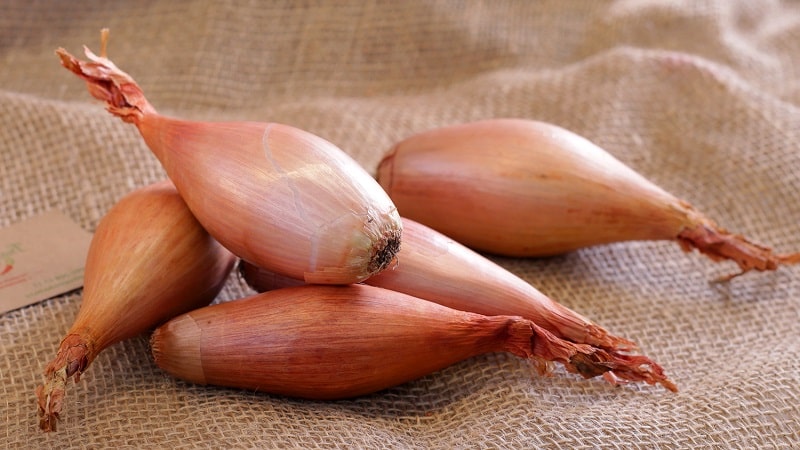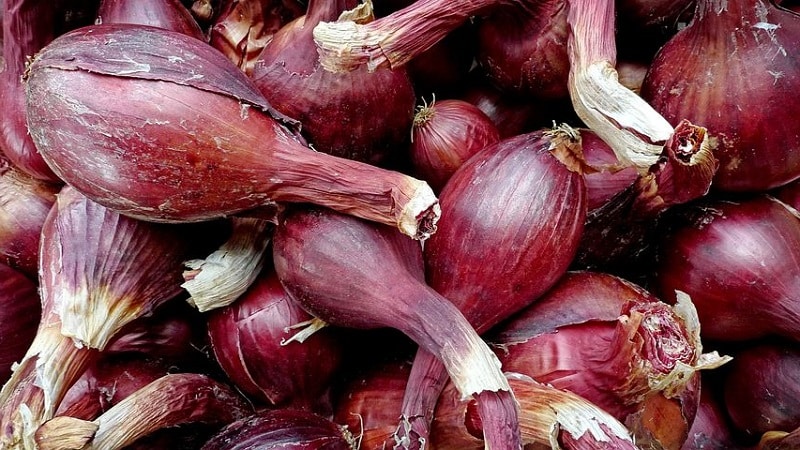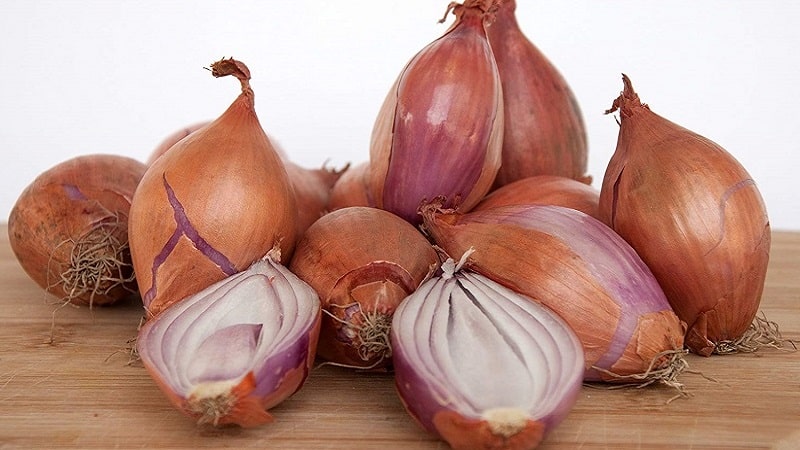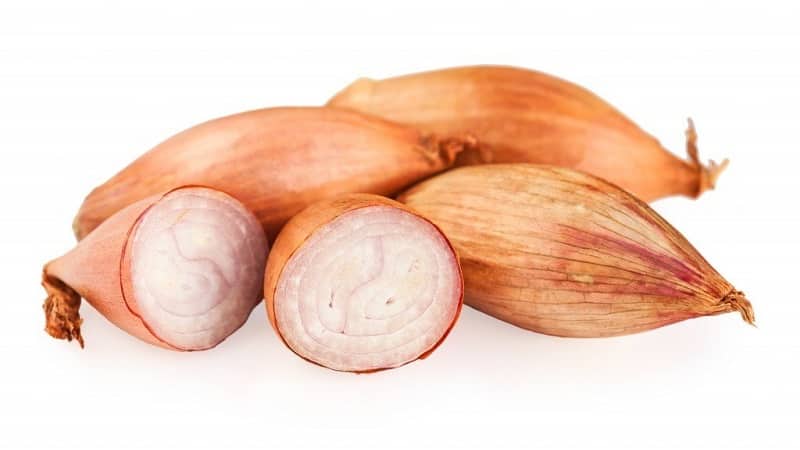Peculiarities of cultivation and folk recipes with shallots
Shallots have gained great popularity among summer residents due to their versatility and unpretentiousness. It is widely used in cooking and medicine. Distinctive features are cold resistance and long shelf life. When growing, pay attention to the rules of planting and care.
In the article you will find details of cultivation and features of use of shallots.
Shallot - what is it?
Shallots have high yields, small heads and excellent keeping quality.. Its main value is greenery. It is very juicy and contains a large amount of vitamins. During the growth process, in the first year it forms up to five turnips in the nest, in the second year - up to 15.

Varieties and varieties
Shallots are becoming more and more popular among summer residents, thanks to which breeders are developing more and more new varieties, specially adapted to climatic conditions.
Among the most popular are:
- Kuban yellow. Mid-early variety. The bulb is dense, round in shape with 3-4 rudiments. Productivity from one bush is 65-100 g. Resistant to drought. Refers to semi-sharp.
- Belozerets-94. Early ripening variety. The growing season is 85 days. The bulb is oval in shape with dense scales. The outer scales are dark lilac. Productivity from one bush is 100-120 g.
- Kunak. Ripening time is 90-100 days. The upper scales are yellow. Has high keeping quality. The taste is spicy.
- Berezovsky aristocrat. Mid-season variety. The bulb is elliptical in shape.Weight 60 g, up to 5-7 heads are formed on one bush. The upper scales are dark yellow. It has a semi-sharp taste.
- Sturdy. According to the growing season, it is classified as mid-late. The bulb is round and small in size. 4-6 pieces are formed in the bush. The outer scales are pink, the inner ones are red.
- Sir-7. Early ripening variety. The bulb is round-flat in shape. Weight 20-40 g. Outer scales are golden yellow. 4-7 heads are formed on one bush. Has high keeping quality. The taste is spicy.
Origin and development
Shallots have been cultivated for centuries. Asia is considered the birthplace of culture. Since ancient times, the onion family has been grown in countries with warm climates. But thanks to the work of breeders, cold-resistant varieties appeared, which made it possible to grow shallots everywhere.
Chemical composition and beneficial properties
Shallots are recommended for those who monitor their health and are on a diet.
It has high nutritional value:
- proteins - 2.5 g;
- fats - 0.1 g;
- carbohydrates - 13.6 g;
- dietary fiber - 3.2 g;
- water - 80 g;
- calories - 72 kcal.
Content of vitamins and minerals in shallots per 100 g:
- potassium - 13.4%;
- manganese - 14.6%;
- vitamin B6 - 17.3%;
- C - 8.9%.
The substances that make up onions have beneficial properties:
- support immunity and restore the nervous system;
- accelerate the healing of wounds from insect bites;
- improve metabolism;
- stabilize blood pressure;
- stimulate brain function and improve memory.
Ripening period, yield, disease resistance
Already a month after sowing, the green leaves are ready to eat.
According to the growing season, it is divided into:
- early varieties - up to 85 days;
- average - from 85 to 120 days;
- late - up to 150 days.
Average onion productivity from 1 m² to 6 kg.
Important! Early ripening varieties are used to grow shallots to produce greens.
The variety is resistant to diseases, rot and pests. It has high shelf life and is not affected by green mold rot during storage.
Characteristics of the bulb
Biennial plant. In the first year, 5 small bulbs are formed on it, and in the second year of cultivation there are 2-3 times more of them. Visually, shallots resemble onions, only small in size. The bulb is more elongated, teardrop-shaped, weighing on average 50 g.
The color of the upper scales varies from yellow to purple. The pulp is juicy. It has a distinct taste ranging from spicy to sweet. The greens are tender and thin. Reaches up to 40 cm in length. Winter-hardy.

What regions is it suitable for?
Due to its drought and cold resistance, the crop is considered universal. Shallot is recommended for all growing regions.
The main advantages and disadvantages of the variety
Advantages of the variety:
- a large amount of vitamins and microelements;
- short growing season;
- high productivity;
- rapid growth of green mass;
- adaptation to weather conditions.
Disadvantages of the variety:
- demands on soil;
- during winter planting, productivity decreases;
- small turnip size.
What is the difference from other varieties
Distinctive characteristics of the variety:
- unpretentiousness to weather conditions;
- long shelf life;
- excellent taste characteristics;
- a large number of useful elements;
- resistance to onion diseases and pests.
What is the difference between shallots and onions? Smaller heads in nests, juicy and sugary pulp, high keeping quality and frost resistance.
Where is shallot used?
Recipes for cooking with shallots are numerous and easy to follow. For culinary purposes, use fresh, frozen or pickled vegetables.
Thanks to its high taste The uses of onions in cooking are varied:
Shallots caramelize beautifully because they have more sugar and less water.
It is used in folk medicine:
- for the treatment of infectious diseases;
- for headaches;
- to normalize blood pressure and cardiac activity due to the sodium and potassium content;
- improved vision.
Being an antioxidant, onions remove toxins from the body and slow down cell aging.
Traditional medicine recipes
Recipes for using shallots:
- At high temperature. Shallots are used fried. Take a couple of onions, chop and fry. Place in a paper bag and apply a compress to the chest.
- When coughing. Take 1 onion, peel, finely chop and add 2 tbsp. l. Sahara. Stir and leave for a couple of hours. Take syrup 2 tbsp. l. every 2 hours.
- For headaches. Take a fresh onion. Cut in half and apply to your temples until the pain subsides.
- To improve vision. Fresh onion is grated and the juice is squeezed out. Mix onion and honey in a 2:1 ratio. Place 1-2 drops into the eyes once a month.
Frequent consumption of shallots is contraindicated for people with gastrointestinal diseases.

Features of planting and growing
To obtain an excellent harvest, follow the rules of care, collection and storage.
Preparing for landing
Before planting shallots, prepare the place and seed.
Location requirements:
- illuminated, ventilated;
- predecessors - legumes, cabbage, tomatoes;
- proximity to strawberries, radishes or carrots for protection from pests.
Preparation of seed material:
- For planting, choose bulbs with a diameter of 2-3 cm;
- dry and sick ones are discarded;
- on the day of planting, the bulbs are heated by placing them in a warm place for 8 hours;
- immediately before planting, soak in a solution of potassium permanganate for at least 30 minutes.
Soil requirements
The process of soil preparation begins in the fall.
Important! You cannot apply fresh organic fertilizer to onions.
Soil requirements:
- light, loose soil;
- moderately moisturized;
- fertilized;
- with neutral acidity.
Preparing the soil for planting:
- In the fall, dig up the area and add a nutrient mixture: 6 kg of compost, 50 g of superphosphate and 200 g of ash. The finished solution is designed for 1 m²;
- In early spring, nitrogen is added - 25 g/m2.
Heavy clay soils are not suitable for growing shallots. - the bulbs will turn out small.
Dates, scheme and rules of planting
Shallots are resistant to low temperatures, but despite this, it is not recommended to grow them before winter.
Important! Prolonged exposure to low temperatures increases the percentage of bolting.
Sowing onions begins when the soil is physically ripe, when the arable layer warms up by 10 cm.
Landing dates:
- for greens: March - April;
- on turnips: April - May.
Planting scheme:
- planting depth - 2.5 cm;
- distance - 25 X 25 cm.
Rules for planting shallots:
- On the day of planting, treat the seed with a concentrated manganese and saline solution. Soak for 30 minutes, dry and begin planting.
- Plant onions in soil with a temperature not lower than +12°C.
- Before planting, mark grooves 4-5 cm deep and fill them with water.
- The neck of the onion is left 2-3 cm above the ground.
- During prolonged cold spells, cover the plantings with covering material.
Favorable temperature for growing - +20°C, but the plant tolerates drops to -5°C.

Features of cultivation
Shallots are a biennial plant. In the first year, sets are grown from seeds. In the second year, full-fledged bulbs are already obtained.
Rules for growing shallots:
- Place the seed in a vessel with warm water. All seeds that remain on the surface of the water should be discarded - these are non-germinating specimens.
- Sowing is carried out in pre-fertilized, moist soil.
- Sow the seeds in rows with row spacing of 20 cm.
- The seeding depth is 1 cm.
Nuances of care
Crop care consists of timely watering, fertilizing and loosening as necessary.
Watering mode
Watering mode directly depends on weather conditions during the shallot growing period. Do not water in rainy weather.
In dry weather:
- at the beginning of active growth every 2-3 days;
- 20 days before harvesting, watering is stopped.
Used for irrigation warm water.
Loosening the soil and weeding
During the period of active growth, onion beds are weeded, thinned and loosened. It is enough to carry out three weedings per season. This is done mechanically using a hoe. Simultaneously with weeding, the loosening process occurs.
Top dressing
Two feedings are carried out per season:
- 22 days after planting, dilute a mixture of manure and water 1:10.
- 45 days after planting, phosphorus and potassium fertilizers are applied at the rate of 15 g per 1 m².
The application of fertilizers as top dressing is combined with watering.
Disease and pest control
Diseases and pests affect onions if care rules are not followed.:
- Downy mildew. Oval, pale green spots appear on the feathers. Over time they increase.The plant is sprayed with Profit Gold every 12-15 days until the symptoms disappear.
- Rust. At the beginning of summer, small warts appear on the feathers. Copper oxychloride is used for control. Take 40 g of the substance and dissolve it in 10 liters of warm water.
- Green mold rot. Accompanied by the formation of brown spots on the upper scales. To prevent onions from getting sick, they are thoroughly dried after harvesting and regularly sorted during storage.
- Cervical rot. The development of the disease begins in mid-summer. Once in the neck of the bulb, the fungus softens the tissue, the bulb becomes watery, and an unpleasant odor appears. To fight, use “Mikosan”, “Quadris” or “Pentophage”.
Pest Control:
- Onion fly. If larvae are found, spray with a salt solution - 1 tbsp. for 1 liter of water.
- Onion nematode. For preventive purposes, bulbs are dipped into a solution with 4% formaldehyde before planting for 15-20 minutes. Dry and plant.
- Aphid. Use the insecticide "Verticillin" or a decoction of pepper, chamomile or potato peelings.

Harvest and storage
Harvest dates depend on climatic conditions during the growing season of the crop.
Important! Early harvesting will reduce the shelf life, late harvesting will provoke the re-growth of green feathers.
How and when to collect
Plantings are harvested when 90% of the tops have turned yellow and died, in August-September:
- Dig up the shallots and clear them of soil.
- Divide the nest into separate turnips and trim dry feathers, leaving a neck 3-5 cm high.
- Dry the onions thoroughly before storing them.
Storage features and keeping quality of the variety
A distinctive feature of shallots is their high shelf life and preservation of beneficial properties.
Storage Features:
- maintaining a temperature of +15°C;
- dark, ventilated room;
- humidity 75-85%.
What difficulties may there be when growing
Difficulties in growing:
- stagnation of moisture in the beds, which leads to rotting of the bulb;
- darkened, unventilated place for planting;
- applying organic fertilizers directly to the crop;
- infected seed.
Advice from experienced gardeners
When cultivating shallots experienced gardeners recommend:
- Follow the planting pattern. Avoid thickening.
- Follow cleaning deadlines. Carefully monitor the formation of the bulb.
- Cleaning should be done in dry weather. Dry the onions thoroughly before storing.
- Disinfect and ventilate the storage area.
- Avoid excessive fertilization and watering of crops.

Reviews of shallots
Shallots are actively discussed on Internet forums. The culture is popular in all regions due to its unpretentiousness and beneficial properties.
Anastasia, Irkutsk: “I’ve been growing shallots for more than 10 years. It came to us by accident - several lilac-colored bulbs. The feathers of the family onion are delicate and exceptionally tasty. Salads with it are simply excellent! The only thing I didn’t like was that the bulb was too small.”.
Alexander, Pavlov: “Two years ago I got acquainted with shallots - a friend recommended it. I planted it without any hope. A worthy onion has grown! It withstood the rainy summer well and delighted with its excellent greenery all season. I lay there all winter until the next season.”.
Conclusion
Shallots are distinguished by their unpretentiousness and early ripening. Due to its high content of nutrients and excellent taste, it is actively used in cooking and folk medicine. If all planting and care requirements are met, you will get an excellent harvest.And correct harvesting times will extend the shelf life of shallots.